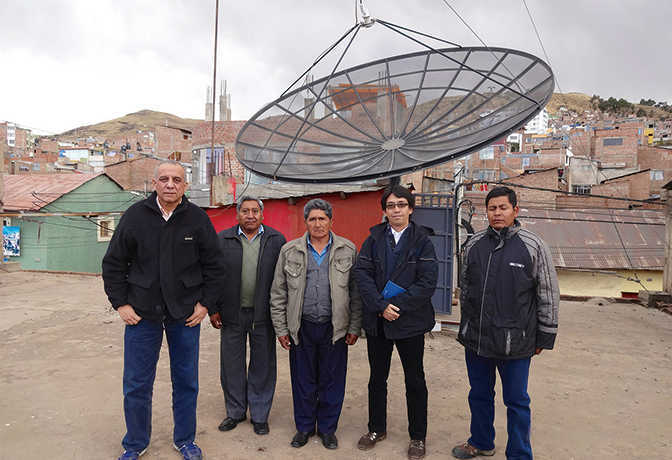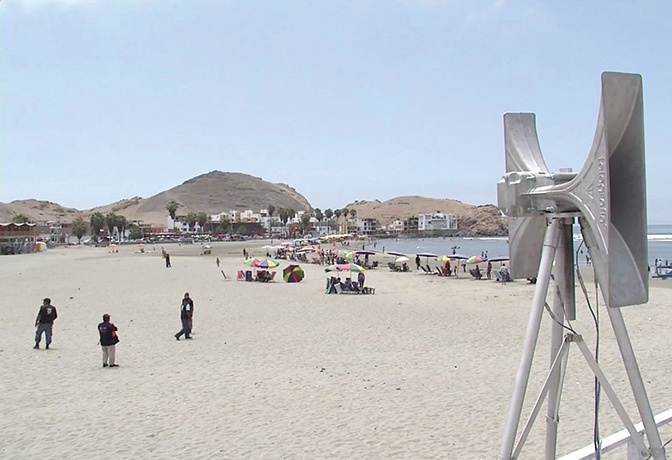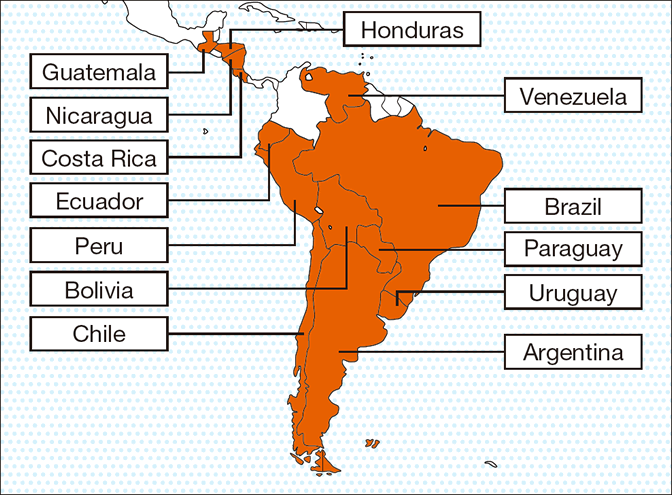The transition to digital terrestrial television broadcasting is progressing in various countries around the world. Broadly speaking, there are currently four standards: Japanese, North American, European, and Chinese. Most countries in South America use Integrated Services Digital Broadcasting–Terrestrial (ISDB-T), the so-called Japan/ Brazil standard, based on Japanese technology. Strong points of the Japan/Brazil standard include the ability to transmit high-definition images and data in digital form and to broadcast to mobile devices. Furthermore, the equipment is of good quality and does not break down easily, with long-term operational maintenance ensured by thorough follow-up service from Japanese manufacturers. These strengths have received positive evaluation, with 13 countries in Latin America having adopted this standard as of September 2016.
Hirose (right) stands next to ATV Group CEO Marcello V. Cuneo at a ceremony to commemorate the launch of commercial digital terrestrial broadcasting in Cusco, the first regional city to introduce the system.
Peru decided to adopt the Japan/Brazil standard in 2009. Katsumasa Hirose, a specialist who was assigned to work in Peru for the Japan International Cooperation Agency (JICA), devoted himself to helping to spread the use of digital terrestrial television during his two-year stay there. After taking up his post in 2012, Hirose assisted in launching digital broadcasts at 13 TV stations in Lima, the capital, and its environs. He provided know-how to the stations on how to make the switch from analog to digital broadcasting, and he also offered recommendations for types of broadcasting equipment.
Hirose actively took part in seminars in regional cities to improve commercial broadcasters’ and ordinary viewers’ understanding of digital broadcasting. In Peru, there is a fixed idea that to be able to watch television with a highquality picture, viewers need to pay to subscribe to cable TV service. “I wanted to let people know,” he says, “that with digital terrestrial television they could enjoy a beautiful picture on their TV screens for free.” He cannot forget the reactions of seminar participants when he showed them scenes from the digital terrestrial broadcast of the 2014 FIFA World Cup in Brazil. “Is the picture really this good? I want it now!” they said as they crowded in front of the screen. Hirose also worked hard to facilitate use through the digital terrestrial network of the Emergency Warning Broadcasting System (EWBS), which transmits warnings in times of disaster. As part of Japan’s Official Development Assistance program, grant aid amounting to JPY 700 million (USD 6.7 million) from Japan for the Project for Improvement of Equipment for Disaster Risk Management enabled the development and use of EWBS receiver chips, and TV sets capable of receiving EWBS signals were offered to seven cities in coastal areas. Also, another project independent of ODA was conducted together with INICTEL, the Peruvian national telecommunications research institute, and this resulted in the creation of disaster-warning speakers implanted with chips for receiving EWBS signals, which can be set up on street corners to sound warnings. The Peruvian government has budgeted funds of its own that have enabled the installation of about 70 of these EWBS-compatible disaster-warning speakers.
At an antenna construction site in Puno: Satellite signals received by a parabolic antenna will be transmitted to the surrounding areas by digital terrestrial broadcasting antennas.
A siren combined with an EWBS receiver in actual operation.
(Photo by JICA)
Hirose actively took part in seminars in regional cities to improve commercial broadcasters’ and ordinary viewers’ understanding of digital broadcasting. In Peru, there is a fixed idea that to be able to watch television with a highquality picture, viewers need to pay to subscribe to cable TV service. “I wanted to let people know,” he says, “that with digital terrestrial television they could enjoy a beautiful picture on their TV screens for free.” He cannot forget the reactions of seminar participants when he showed them scenes from the digital terrestrial broadcast of the 2014 FIFA World Cup in Brazil. “Is the picture really this good? I want it now!” they said as they crowded in front of the screen. Hirose also worked hard to facilitate use through the digital terrestrial network of the Emergency Warning Broadcasting System (EWBS), which transmits warnings in times of disaster. As part of Japan’s Official Development Assistance program, grant aid amounting to JPY 700 million (USD 6.7 million) from Japan for the Project for Improvement of Equipment for Disaster Risk Management enabled the development and use of EWBS receiver chips, and TV sets capable of receiving EWBS signals were offered to seven cities in coastal areas. Also, another project independent of ODA was conducted together with INICTEL, the Peruvian national telecommunications research institute, and this resulted in the creation of disaster-warning speakers implanted with chips for receiving EWBS signals, which can be set up on street corners to sound warnings. The Peruvian government has budgeted funds of its own that have enabled the installation of about 70 of these EWBS-compatible disaster-warning speakers.
Hirose has great expectations for the potential of digital terrestrial broadcasting, which originated in Japan. Peru began to use disaster-warning systems before other regions in South America. The Japanese system has now become the standard used in South America, and other regions prone to natural disasters are considering expanding EWBS by taking advantage of the special features of digital terrestrial broadcasting.
Since returning to Japan, Hirose has kept in regular contact with the person who succeeded him in Peru, providing ongoing support. Though Peru is separated from Japan by 15,000 kilometers (over 9,000 miles), his ties with the country are still strong.
Wide use of the Japan /
Brazil standard in Latin America
Brazil adopted the Japan/Brazil standard in 2006, and now most Latin American countries have adopted this standard, which originated in Japan.
Six special features of the Japan /
Brazil standard
he standard, originating in Japan, has special features in addition to highdefinition broadcasting. These include multiple-channel broadcasting, interactive functions like answering a survey while watching a program, as well as functioning as infrastructure to reduce disaster risks by broadcasting emergency warnings. Data broadcasting has already begun in Peru with weather information data-casting.
Katsumasa Hirose
Joined the Japanese publ ic broadcaster in 2000. Was in the Engineering Administration Department, involved in maintaining the file base system for news programs. From October 2012, was assigned to Peru by JICA to provide expertise for the introduction of broadcasting infrastructure and to train engineers. Assisted in the launch and spread of digital terrestrial broadcasting in the Lima area.




































































































































